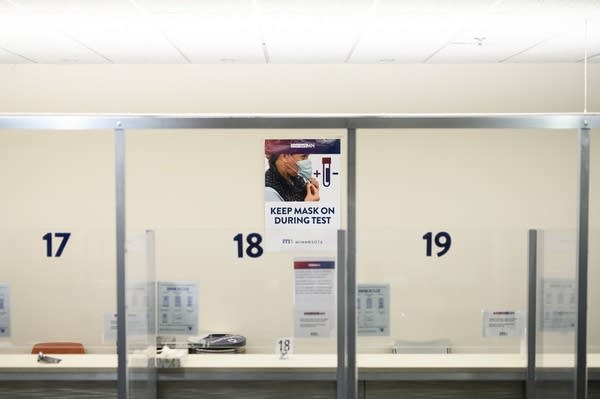CDC puts much of Minnesota at low risk of COVID this week

Go Deeper.
Create an account or log in to save stories.
Like this?
Thanks for liking this story! We have added it to a list of your favorite stories.
Happy St. Patrick’s Day to those who celebrate the holiday! Coincidentally, the CDC’s map of Minnesota’s COVID-19 “Community Levels” is almost entirely green, indicating low risk of COVID throughout the state.
On the whole, COVID data in Minnesota is encouraging this week, with most metrics indicating the virus is on the decline in the state.
Last week, we shared information about how older adults continue to face the highest rates of hospitalizations and deaths, while also seeing lower rates of hospitalizations and deaths if boosted.
This week, we look at the CDC’s data of contributing causes listed on COVID death certificates, and we see other groups of people that might be at higher risk.
Turn Up Your Support
MPR News helps you turn down the noise and build shared understanding. Turn up your support for this public resource and keep trusted journalism accessible to all.
Among the top five conditions listed as most commonly contributing to COVID deaths in Minnesota, three are more likely to be pre-existing conditions — hypertensive diseases, diabetes and vascular dementia. These conditions had a higher rate of prevalence among Minnesota COVID deaths than for the U.S. as a whole.
The other two contributing causes, influenza/pneumonia and respiratory failure, could be pre-existing or could be factors tied to COVID. In contrast to the other three conditions, the rates for these two contributing causes were higher for the U.S. as a whole than for Minnesota.
While these are overall trends and important to note, we shouldn't lose sight of the fact that COVID deaths in Minnesota are declining, alongside other metrics. Let's turn now to what the data has to tell us this week.
COVID cases, hospitalizations and deaths continue to decline
COVID cases continue to fall in all regions of the state, as well as cluster to a similar case rate of around 50 cases per 100,000. These are officially-reported cases, generally reported via healthcare providers. They do not include at-home tests.

Intensive care unit COVID admissions are up after reaching a low last week. Non-ICU admissions are down somewhat from last week’s data.

Taking the longer view, non-ICU COVID admissions are notably well below what they were for much of 2022. Non-ICU admissions also fell sharply in February for the last two years. In 2021, those admissions then began to rise in March, while in 2022 they rose in April. It remains to be seen if and when we will see a similar rebound in hospitalizations.

COVID deaths continue to remain lower following the upticks we saw in December and January.

COVID wastewater levels are down throughout state, holding steady in Twin Cities
Twin Cities metro update
The total level of virus in Twin Cities wastewater increased by only two percent for the week ending Mar. 13 compared to the previous week, according to the latest data from the Metropolitan Council and the University of Minnesota’s Genomic Center. The XBB subvariant now comprises 91 percent of the viral RNA load entering the Metro wastewater plant.

The COVID load in Twin Cities wastewater, although lower than what we have seen this year up to March, remains above the levels we saw at this time in 2021 and 2022.
Statewide update
COVID levels in wastewater decreased throughout the state over the prior month and prior week, according to the latest data out of the University of Minnesota’s Wastewater SARS-CoV2 Surveillance Study.
For the period ending on Mar. 5, all the study’s regions experienced substantial declines over the prior month. The North East, South West and Central regions experienced monthly declines between 50 and 60 percent, the largest measured decreases over that period. The four other regions in the study saw monthly declines between 25 and 50 percent.
The North East region also experienced a substantial decline over the prior week of 51 percent, indicating a continuing, somewhat steep decrease in COVID wastewater levels.
All other regions saw smaller declines over the prior week, and the Central region experienced a one percent increase. These weekly changes suggest that the larger monthly declines are leveling off, which can be seen in the graphs below. Whether that leveling off results in a new, sustained plateau remains to be seen.
CDC: The map of Minnesota is green, and not just for St. Patrick’s Day
The CDC rates no counties as high risk in its Community Levels assessment this week, down from two last week. And only five counties are rated medium risk, down from 15 last week. That leaves 82 counties at low risk. (See CDC "Community Level" map above.)
The last time there were no Minnesota counties rated high risk by the CDC was in mid-January.
Traverse and Big Stone counties are both rated medium risk this week, which is an improvement since they have both been at high risk over the last few weeks. This is most likely due to a lower COVID hospitalization rate this week of 11 admissions per 100,000 people compared to last week when the rate was 38 per 100,000 people.
Faribault, Freeborn and Martin counties along the southern border of the state are the three other medium-risk counties. Faribault and Freeborn counties each have a COVID hospitalization rate of 16 admissions per 100,000 people, and Martin has a hospitalization rate of 17 per 100,000 people.
By comparison, last week 17 counties in Minnesota had a hospitalization rate of 10 or more admissions per 100,000 people.
Only seven counties have a case rate that exceeds 100 per 100,000 this week, down from 11 last week and 37 the week before that. Notably, Traverse County, which had a case rate that exceeded 300 per 100,000 last week, has a much lower case rate of 61 per 100,000 this week.


